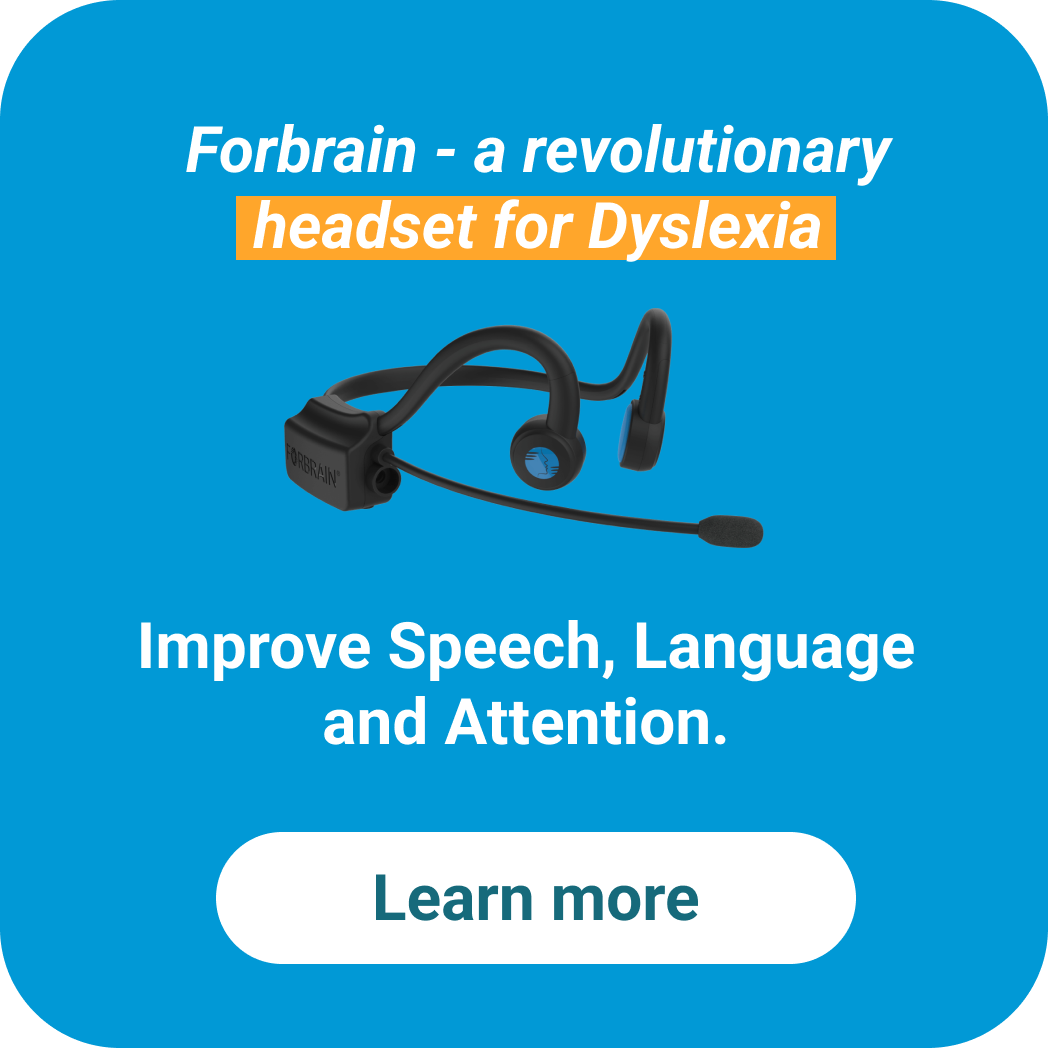Speech Dyslexia: How Does Dyslexia Affect Speech, Challenges & Solutions
 Amy Borel - October 04, 2023
Amy Borel - October 04, 2023 
Can Dyslexia Affect Speech | How Does Dyslexia Affect Speech | Strategies for Speech Dyslexia | Dyslexia and Speech FAQs | Using Forbrain
Although many people are familiar with the term “dyslexia” described as a reading and/or learning disorder, dyslexia can be present in several different ways, some of which affect speech production. The way in which dyslexia affects speech production can vary according to the type of dyslexia, the severity of the disorder, and a person’s age at diagnosis, which affects when intervention can begin. The earlier the intervention, the more likely the person will avoid further learning disabilities or falling behind academically. This article aims to explain the ways in which speech dyslexia (also known as Phonological Dyslexia) can affect one’s speech production, commonly observed symptoms, and solutions to help improve speech-related difficulties caused by the disorder.
Can Dyslexia Affect Speech
The most common type of dyslexia affects speech in a way that is characterized by difficulties with phonetic (sound) production or sound decoding or encoding (matching sounds to their symbols, such as letter combinations and words, both in speech production and comprehension). This type of dyslexia is initially observed as a difficulty “sounding out words” while reading aloud. For the purpose of this article, speech dyslexia and dyslexia may be used interchangeably.
Does dyslexia affect speech? The short answer is yes, dyslexia is a language-learning disorder, and it has the potential to affect a person’s speech in a variety of ways, which we’ll discuss below.
Firstly, it’s important to know that a person with speech dyslexia does not have difficulties related to hearing, vision, or intelligence. Therefore, it is important that deficits in these areas are ruled out before seeking a diagnosis of dyslexia. It should also be noted that although the exact reasons for dyslexia are unknown but are associated with preterm birth, low birth weight, exposure to infectious diseases or drugs during pregnancy are all considered risk factors. Children with a familial history of dyslexia (parent or sibling) tend to have about a 45% higher risk of developing a type of reading disorder such as dyslexia. Many children with dyslexia are first identified by teachers during the early stages of learning to read, but it is possible that a person is not aware they are dyslexic until adulthood. Dyslexia cannot be cured, but early intervention with a qualified professional such as a reading specialist or Speech-Language Pathologist can help.
How Does Dyslexia Affect Speech?
If dyslexia is generally considered a reading or learning disorder, how exactly does dyslexia overlap with speech? Dyslexia typically occurs on a spectrum, which is to say that no two people with dyslexia have the same difficulties. One person can have difficulties with certain types of reading or other academic exercises, while others may have a more generalized difficulty with other learning abilities. The same is true for how dyslexia can affect a person’s speech.
Speech Dyslexia is a type of disability that can affect any or all of the following:
- Reading
- Spelling
- Comprehension (verbal or written)
- Speech production
The overlap between reading difficulties and speech problems in dyslexia is well-known by linguistic professionals and can be partially identified as a person who may experience several types of the following:
- Delayed speech production as young children
- Difficulties learning new and/or complex words and how to pronounce them
- Making errors in articulation or pronunciation or mixing up words
- Inability to recognize or pronounce real or fake words (an example of a fake word could be “brumilla”–the sounds can be pronounced, even though the word does not exist)
- Difficulty recalling words when telling a story or having a conversation
- Difficulty forming answers to questions
As you can see, there are many different ways in which dyslexia can affect speech production. Let’s look a bit closer at some of the main reasons why.
Lack of Phonological Awareness
Phonological awareness is a term that describes a person’s ability to recognize and manipulate certain speech sounds. For example, a person may pronounce the word “with” as “wish” or “sgabetti” for “spaghetti.” It can also be difficult to recognize syllables and how to put them together to correctly form words. These types of errors can be common during the developmental stages of speech production (usually through third grade), but for those with dyslexia, these types of errors can continue well into higher-level education creating speech delays and/or other learning disabilities.
Articulation and Pronunciation
Articulation and pronunciation of words are two separate ways to describe how a person speaks.
Articulation refers to whether a person is speaking in a clear, understandable manner. Pronunciation is a person’s ability to accurately produce the target sounds.
For a person with dyslexia, difficulties can appear in one or both areas. Difficulties in articulation may appear as a listener’s misunderstanding of what the dyslexic person is trying to say because of poor articulation. Difficulty pronouncing words for a dyslexic person appears as incorrectly saying words, difficulty sounding out words, or even difficulties producing simple syllables or single letters.
Processing Speed
Processing speech in speech is imperative to understanding new information and is heavily related to the brain’s working memory. A person’s ability to process new information requires that their working memory holds the new information long enough for it to be understood and moved into long-term memory. A person with dyslexia who also has difficulty with processing speed and/or working memory may experience the following speech difficulties:
- Responding in a conversation
- Reading a new word
- Paraphrasing information
- Verbal Problem solving
Fluency and Confidence
Speech fluency refers to the rate, rhythm, smoothness, and effort required to speak in a natural, understandable way. A problem with speech fluency is referred to as a dysfluency, which can be as simple as using fillers such as “uh” or “um,” or having more severe difficulties such as stuttering. Children and adults who experience speech dysfluencies frequently experience psychological, emotional, social, and functional consequences from their dysfluencies, including social anxiety, a sense of loss of control, and negative thoughts or feelings about themselves or about communication.
Sentence structure
Sentence structure refers to the grammatical aspects of forming a sentence. Because people with dyslexia tend to have difficulties structuring language as a whole, their ability to construct a grammatically correct sentence is also affected. For a person with dyslexia who is speaking, this may look like difficulties organizing the parts of a sentence, how to get them started, or confusing nouns, pronouns, or verbs, for example. These difficulties are often seen in their writing abilities as well.
Strategies for Speech Dyslexia
Strategies for addressing the difficulties related to speech dyslexia vary depending on a person’s age, the severity of their deficits, the results of dyslexia asssessments, and the recommendations of professionals including teachers, reading specialists, and in most situations, a Speech-Language Pathologist or other therapists who specialize in reading, language, and speech disorders.
Speech Therapy
Seeking the help of a reading specialist or Speech-Language Pathologist is an important part of helping a person with speech dyslexia overcome their difficulties with communication as a whole. A well-educated professional will have the tools to assess the extent of the difficulties, address specific academic or social issues as a result of the speech dyslexia, and create a treatment plan with specific goals to help the person with dyslexia thrive. A good therapist will write a treatment plan that addresses most, if not all, of the following exercises.
Phonological Awareness Training
Phonological awareness training is one of the most important tools when beginning treatment for dyslexia because it is a lack of phonological awareness that is the hallmark of the disorder.
Examples of phonological awareness training or exercises may include:
- Songs, rhymes, or tongue twisters (also excellent for working memory)
- Word games that require repetition of words
- Counting syllables in words, or words in sentences
- Repeating phrases spoken by a parent or therapist
- Feedback activities such as using a mirror to watch how the mouth, teeth, and tongue move when saying certain words
- Present syllables and ask the person to blend the syllables to make the correct word
- Identify the “odd word out” (give a short list of words with all the same endings but one with a different ending and ask them to identify the one that is different)
- “I spy” exercise, only in this version say “I spy something that begins with the letter. . .”
- Present the person with nonsense words and ask them to change some letters to make a real word. For example, say “How can we make the word zook into a real word?” “Change the ‘z’ to a ‘b’ and that spells the word book!
Articulation Exercises
Articulation exercises in speech therapy will likely be similar for a person with dyslexia, as they are to a person with a specific articulation disorder. These exercises aim to improve communication by “fine-tuning” the way a person speaks so that others can understand them better. Oftentimes these exercises include revisiting basic vocabulary in the form of cards with pictures and/or written words, and using specific strategies to help correct the misspoken sound or word. Once these skills have been improved, new vocabulary can be added. Treatment plans for articulation difficulties must be adapted to the person’s individual misarticulations. Not all people make the same articulation errors. Examples of exercises include:
- Letter and word games (age-appropriate, with a limit of only a few people at a time, and also adapted to the dyslexic person’s attention span)
- Feedback exercises using mirrors, audio-feeback devices (recording one’s voice, using a microphone, or using specialized neurofeedback devices that allow a person to hear what they are saying in real time)
- A large variety of oral-motor exercises to practice correct positioning of the tongue, lips, teeth, breathing patterns, etc.
Practice Reading Aloud
Reading aloud is necessary to help improve literacy skills for all people, and especially for someone with dyslexia, who can benefit from improved working memory, increased vocabulary, increased attention, and improved articulation/pronunciation. Reading aloud allows us to:
- Recognize errors in our speech production (by oneself or another listener)
- Identify difficulties with working memory (reading a sentence or short story and recalling or summarizing the content)
- Improve language processing skills
- Improve written language. Spoken language is different from written language and the more we read aloud, the better our writing can become.
- With time and improvement, find pleasure in reading, increase vocabulary (simple or technical) and perfect appropriate rate, rhythm, and intonation
Use of assistive technology
Assistive technology is a term that refers to different types of devices that help people with their everyday lives. These can include things like walking canes, wheelchairs, or hearing aids. Within the realm of language learning and people with dyslexia, there are options for the use of assistive devices. An example is called Forbrain, an assistive device which stimulates and facilitates the brain through several processes, one of them being neurofeedback. Neurofeedback (also called biofeedback) is a type of assistive method that increases the feedback our brain receives while we’re completing a task. These devices may improve attention span by letting us know when we are drifting away from a cognitive task, detect mood changes so that we can reframe our thoughts, or even devices that can be used while playing video games, working on a computer, or completing daily tasks.
Vocabulary Building
Most of the strategies discussed so far help build vocabulary in one way or another. There are additional strategies that can be used in formal (classroom or therapy) or informal (at home) environments and many of them can be modified so that they are entertaining to children. Examples of ways to build vocabulary:
- Remember the game “Memory”? Why not use this game with new target words?
- Use new vocabulary words to write or tell short stories. Discuss their definitions.
- Antonym (words with opposite meanings) / synonym (words with similar meanings) games. Choose words, discuss the definitions and then take turns listing their antonyms or synonyms.
- For some adults, technical vocabulary words may be used in the same activities, but with the goal of refining the language to meet a particular subject or career specialty.
Dyslexia and Speech FAQs
What is speech dyslexia called?
Speech dyslexia is one type of dyslexia called Phonological Dyslexia.
What type of speech disorder is dyslexia?
Phonological dyslexia is a speech disorder that is characterized by a person who has difficulties identifying the sounds associated with letters or groups of letters.
Can dyslexia make you mix up words?
Yes, one of the main ways we can identify people with dyslexia is by their tendency to mix up words. This can look like difficulties finding the correct word to say something, mispronouncing words, or mixing up certain sounds included in the words.
Why is speaking to a group of people difficult for someone with dyslexia?
A person with dyslexia may not feel confident speaking in front of others, especially when speaking to a group of people. Fear of making errors in their speech or experiencing embarrassment about those errors can cause the person anxiety when speaking publicly.
Do dyslexic people need speech therapy?
Speech therapy or other qualified specialists are an integral part of learning to live with dyslexia and gain confidence in reading, writing, and speaking. Such specialists are qualified to improve a person’s ability to recognize, recall, and correctly produce verbal language.
What words do people with dyslexia struggle with?
The most difficult words for people with dyslexia are those with spelling whose sound combinations are not intuitively pronounced. Examples include yacht, through, depot, psychology, etc.
Which language is hardest for dyslexia?
Because dyslexia is a language disorder affecting speech sounds, it can occur in any language. Languages such as French and English, however, can be particularly difficult because the combinations of letters often do not correspond intuitively with their pronunciation.
What are the symptoms of dyslexia in speech?
Symptoms of dyslexia can vary by person, age, and level of educational tasks. Main symptoms in early language learning include:
- Difficulty forming sentences
- Difficulty reading or reading very slowly
- Inconsistent spelling
- Errors of articulation or pronunciation (therefore avoidance of reading aloud)
- Difficulty identifying syllables or how to blend them together
- Poor handwriting
For a more extensive list based on educational level, read here:: https://dyslexia.yale.edu/dyslexia/signs-of-dyslexia/
Using Forbrain to Help with Speaking and Dyslexia
As mentioned above, there are assistive devices that can be used to increase literacy and speech production. One of them is called Forbrain, which is an auditory (hearing) stimulation headset that offers users the ability to practice their speech and language skills while hearing their own voice (through both the ears and the bones behind the ears) and training the brain to recognize and correct errors. The headset includes a microphone, a dynamic speech filter, and bone-conduction to directly stimulate the auditory nerves. The headset sits comfortably around the ears, and the bone-conduction portion rests gently on the bones directly behind the ears, amplifying the voice in real-time.
The positive effects of Forbrain for dyslexia are numerous and have been well-documented in evidence-based literature to offer the following positive effects:
- Improved recall of sight words (words recalled from memory without needing to be “sounded out”
- Increased reading speed and fluency
- Increased reading comprehension
- Sound discrimination
- Target sound production
- Increased working memory for reading longer text
Final Words
Phonological Dyslexia can affect the speech of any person, of any age, and in any language. It is a disorder that typically spans a person’s lifetime, but with the right tools and early intervention, people with this disorder can learn to excel despite the challenges it can cause to language learning, speech, reading, and writing. Speech therapy and other specialized professionals are an integral part of improving a dyslexic person’s ability to succeed in meeting their speech and language needs to avoid further learning disability. The use of assistive devices with a trained professional can help a person with dyslexia improve their speech and literacy in an effective way.
If you or someone you know is struggling with the signs of phonological dyslexia, it’s important to seek an evaluation by a specialist in these areas to determine the best treatment plan. It’s not necessary to wait for an official diagnosis; parents and educators can begin to help by using the strategies listed above and consulting evidence-based activities that are engaging, confidence-building, and effective.
References
Cabbage, Kathryn; Farquharson, Kelly; Iuzzini-Seigel, Jenya; Zuk, Jennifer; and Hogan, Tiffany P., Exploring the Overlap Between Dyslexia and Speech Sound Production Deficits (2018). Speech Pathology and Audiology Faculty Research and Publications. 48. https://epublications.marquette.edu/spaud_fac/48
International Dyslexia Association (IDA). (2020). Oral Language Impairments and Dyslexia. https://dyslexiaida.org/oral-language-impairments-and-dyslexia-2/
Mosaic Health and Rehab. (2021, March 1). Language, Working Memory, and Processing Speed. https://mosaicrehabmt.com/language-working-memory-and-processing-speed/
Neurohealth AH (2022). Types of Dyslexia and How to Identify Them. Read more.
Nobles, Myles, (2023) Children’s Speech Therapy for Dyslexia: What you Should Know. Read more.
Shaywitz, Sally (2005, January 4). Overcoming Dyslexia. The Yale Center for Dyslexia and Creativity. https://dyslexia.yale.edu/dyslexia/signs-of-dyslexia/
Snowling, M. J., and Melby-Lervåg, M. (2016). Oral language deficits in familial Dyslexia: a meta-analysis and review. Psychol. Bull. 142, 498–545.
Tree, J. J. (2008). Two types of phonological dyslexia–A contemporary review. Cortex, 44(6), 698-706.





